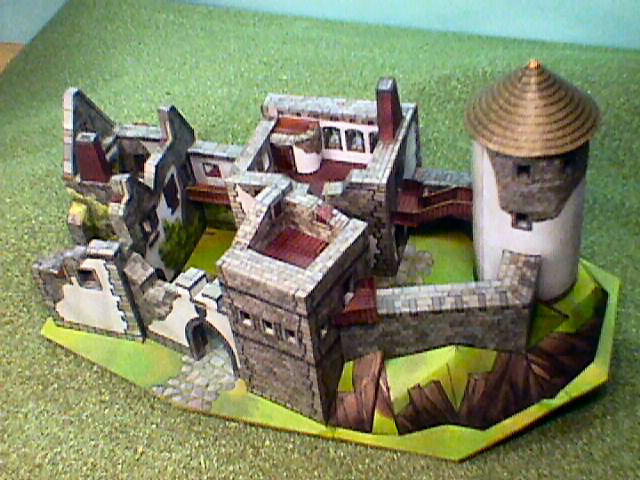|
Click on the thumbnails to view the larger images
|
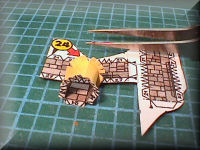 |
After cutting out the first wall, I suddenly realised, with a sinking heart, that the piece shown here was one of the next pieces. For those of you who don't make buildings, the implications of this piece may not strike a chord of the "fun" to follow.
|
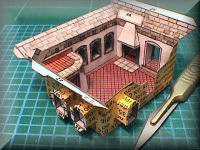 |
This will show what I realised very early on. All the walls are double thickness and all the windows and doors are basic tubes that attach to both inside and outside walls. The tubes have to be glued in perfectly or the two sides of the wall will not match. For this piece, the wall and floor are one piece and the upper brick work is the top of a broken wall. I added all the doors and windows first, then folded up the walls and glued them together. I then added the interior details.
|
 |
Not all the windows are "missing". Those that have stood the test of time remain and are made in the usual ABC fashion. As you will note, they are not the biggest pieces. The wall is the outer wall, so the windows have to be attached before the next step.
|
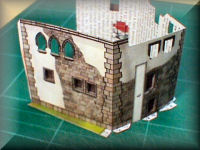 |
And this is the next step! All very innocent really, four walls with a few windows and doors, but note the holes, these carry through to the inner wall from the earlier stage.
|
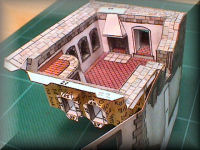
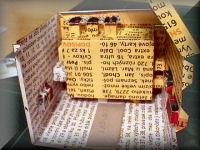
|
I hope that this gives you an idea of the precision needed to add the inner and outer walls. All the windows, doors and top stone work have to be glued in place so that the walls line up when the outer wall is finally glued to itself.
|
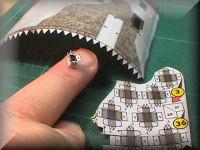 |
This shows part of the tower construction, as can be seen, the windows are even smaller than in the rooms. At least the tower has a roof, so there are no double walls to worry about.
|
 |
The completed tower is added to the base. Here, also, can be seen the format of the ground. I like this style; it doesn't try to pretend that the building material is anything but card. This picture also shows another problem that showed up at the start. That was the fact that the castle is built on two levels. The instructions are only in Czech so it was a matter of trial and error to work out how high the base had to be.
|
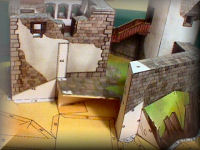

|
Here you can see the two levels. I glued a piece of thin card to the upper level to help the attachment of the pieces. You can also see the base sheet. This has all the placement lines, including the tab placement. These pictures demonstrate the quality of the kit because all the pieces fit perfectly on their line, despite my efforts in putting the pieces together.
|
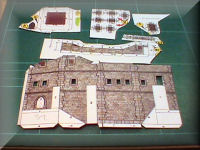
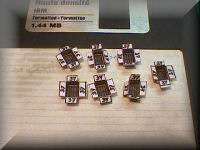
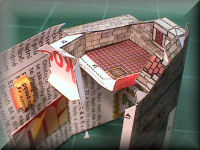
|
This series of pictures show the process of building one of the towers. Unlike the earlier room, the long, thin piece is the inner wall that is attached to the floor around the red floor. The windows are attached to the outer wall and the tabs on the outer wall make up the top of the wall. I decided to glue one side of the inner wall to the floor, then add the outer wall and then move onto the next side of the inner wall. In this way it was easier to get to the tabs on both walls. It sounds complicated (it is!) but I hope the last picture shows the process.
|
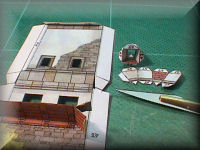 |
Here is a variation on the earlier theme. We have the inner and outer walls in one piece. The two tunnels are glued to one side of the wall, then the wall is folded over and the other end of the tunnels are glued in place. Note that the tunnels are narrower at one end, so there is a definite way round to them. With the tunnels in place, the two walls are almost impossible to maneuver, so it's imperative that the tunnels are placed exactly. If not, the wall will never be square when the two halves are glued together.
|
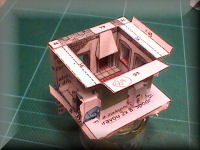 |
Another room, similar to the first one. This time, however, there is another room to be added before the outer wall is added.
|
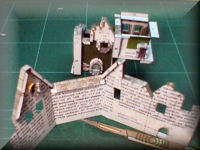 |
Here we have the two rooms and the outer wall. The top of this wall has many angles so it wasn't difficult to find where it fitted to the inner walls!
|
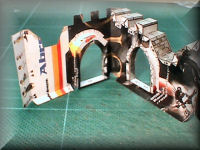 |
This shows the start of the main gate. Like most of my pictures it's a bit fuzzy, but you may be able to see that the left hand arch is bigger than the right. Now that the arches are added to the walls, they are folded round and the arches are glued together. As mentioned earlier, they must be glued together accurately so that when the box that makes up the wall is formed, everything is square.
|
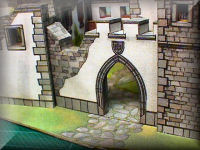
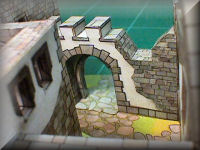
|
Two pictures of the gate, I will leave you to decide on the squareness of the fit. Again I must mention the quality of the kit. The walls either side of the wall with the gate, had already been placed on the base.
|
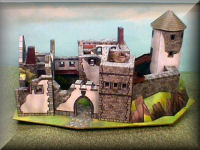
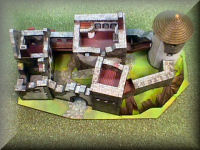
|
The finished model. To give you an idea of the scale, the castle is less than 10 inches long.
|

